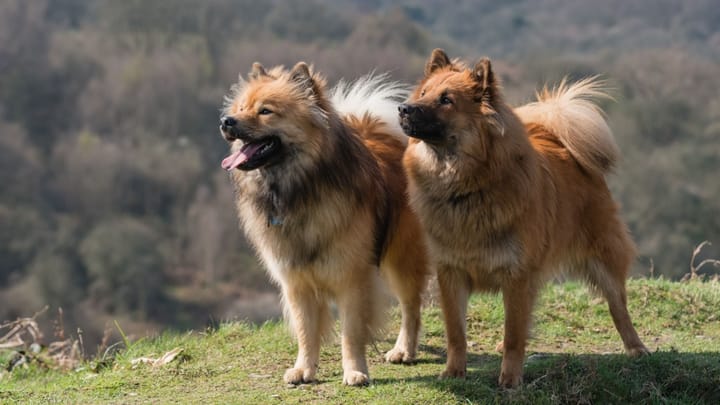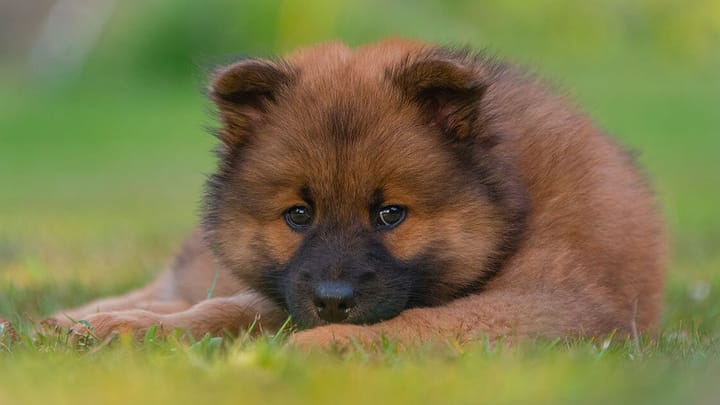Eurasier
Other names : Eurasian dog, Eurasian


The Eurasier is a medium-sized dog sporting a thick coat that endows him with a proud and majestic appearance. He is a very pleasant life companion, and is remarkably sociable towards fellow dogs as well as all other animals he encounters. Very attached to his social group- yet without being overly clingy- he adapts quite seamlessly and enthusiastically to various possible lifestyles and takes great pleasure in becoming an integral part of his owners’ day-to-day.
|
Life expectancy |
The Eurasier has a life expectancy of between 11 and 13 years |
|
Temperament |
|
|
Size |
Medium
|
|
Adult size |
Female
Between 19 and 22 in
Male
Between 20 and 24 in
|
|
Adult weight |
Female
Between 40 and 57 lb
Male
Between 51 and 71 lb
|
|
Coat colour
All coat colours are admissible, barring pure white, white patching, or liver. |
Black Blue Red Sand |
|
Type of coat
The coat is medium-long. The topcoat lies flat throughout the dog’s body, without being close-lying, and ranges from short to medium-long hair, depending on the area. The undercoat is abundant. |
Short Long |
|
Eye colour
The eyes are dark. |
Brown
|
|
Purchase price |
The Eurasier costs between £730 and £1280 |
This is a relatively rare breed- counting some 8,500 specimens around the globe, most of which reside in Europe, and mainly in Germany, which is his country of origin. Being a relatively recent ‘import’, the United Kingdom is home to a relatively small number of specimens.
More details about the Eurasier
Eurasier: Origins and history
This breed owes its existence to the famous ethologist Konrad Lorenz, who attempted to recreate a very ancient, long extinct dog, the Nenets Herding Laika. This ancient Russian dog was the result of a cross between the Wolfspitz (German Spitz) and a Chow-Chow, and lived in a state of wilderness. This same cross-breeding has allowed K. Lorenz to create, or rather re-create, the Eurasier, by commissioning it from the breeder Julius Wipfel, and deciding to add the Samoyed in the mix. In 1973, the Eurasier was officially recognised by the FCI and spread to Germany, Austria, the Netherlands, Belgium, Switzerland and Spain. Unfortunately, his distribution remained limited and this beautiful dog has never fully known much success, perhaps because of his resemblance to the Chow-Chow, the latter being more popular and heard of.
Physical characteristics of the Eurasier
The Eurasier is a medium-sized dog with a long coat, of a rectangular rather than square construction. The head strongly resembles that of its wolf ancestor: cone-shaped, with upright, medium-sized ears, a flat skullcap and a distinct, central wrinkle. The eyes are dark, not too deep-set, and almond-shaped. The limbs are rather big-boned and perfectly straight. The tail hangs low when the dog is at rest, but is worn curled over the back when he is in movement.
FCI classification of the Eurasier
-
Group 5 - Spitz and primitive types
-
Section 5 : Asian Spitz and related breeds
Eurasier: Characteristics
Eurasier: Behaviour
Training a Eurasier
The training process if very simple in this dog’s case, since his many capacities predispose him to fast and obedient learning in various fields. He loves to please his master, not least by proving how easy it is to cooperate with him.
Socialising the Eurasier- which should start taking place when he is still a pup- is also remarkably seamless, given how naturally open this magnificent Spitz is.
Having said this, the Eurasier’s inborn social competence should never justify a lax approach on behalf of his owners! This dog still needs to be reared in a precocious, coherent, fair and consequential manner, without ever allowing brutality to be part of the exchange.
Eurasier: Lifestyle
Breed compatibility Eurasier
Eurasier: Purchase price
The price of an Eurasier varies depending on its origins, age, and sex. You have to count an average of £730 for dogs not registered at the Kennel Club. However, for dogs who are registered, the average price is £1280.
With regards to the monthly budget required to meet the needs of a dog of this size, you have to estimate an average of £60 per month, including quality nutrition, and basic veterinary care such as deworming, vaccines etc
Eurasier: Shedding
Heavy !
Hair loss is significant during the Eurasier’s moulting season- i.e., spring. That is when brushes will need to be daily in order to gradually eliminate as many dead hairs as possible.
Eurasier: Grooming
This Spitz’s abundant coat could initially scare a prospective owner not wanting to spend hours caring for their dog’s locks. Yet this dog does not actually require very complex maintenance. Weekly brushes will be enough to preserve the aesthetic and protective qualities of his coat- ideally with the use of a slicker brush to be able to really reach the undercoat.
This dog does not need to be washed or groomed (except for show dogs, of course). A maximum of two baths a year will be more than enough.
Eurasier: Health
Life expectancy is 12 years on average.
The Eurasier is a robust dog, owing to the crossbreeding of particularly resilient dogs from which he springs. He gets sick only very rarely, and enjoys quite a long life.
When it gets hot, the Eurasian may not be as vulnerable to the heat as some of his peers, but should nevertheless not be exposed to the sun for too long. He will have to have access to all the fresh water he pleases, as well as a spot in the shade to retreat to.
In the summertime, and especially during heatwaves, walks will have to take place early in the morning and in the late evenings, if he is to really get the most out of them.
The Eurasier’s thick top coat, coupled with his abundant undercoat, endow him with a very good resistance to challenging weather (cold and humidity).
Not in excessive need of physical exercise, the Eurasian can quickly gain weight if his nutrition is not properly calibrated. Calibrating his nutritional balance well in addition to daily walks will guide him back to his intended weight.
- Hip dysplasia
- Primary glaucoma (hereditary eye disease)
- Distichiasis (faulty development of hair follicles)
- Entropion
- Dandy-Walker Malformation (hypoplasia of the cerebellum)







